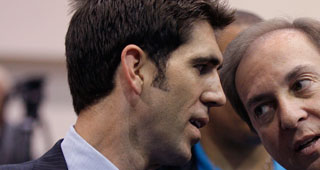The Golden State Warriors made history this season with 73 regular season wins. After just 9 regular season losses, the Warriors lost as many games in the postseason, before falling in an epic Game 7 to the Cavaliers.
The failure to win a title this year shouldn’t detract from all that the Warriors did accomplish. 73-9 is still a record and they were one of the better offensive teams of all-time while also playing very good defense. Over the last couple of seasons they have helped to usher in a new era in the NBA with small ball. They also took the pace and space concept to the extreme by playing quicker and launching more threes than almost anyone.
By emphasizing the ability to pass the ball above all else, the Warriors created a relatively equal opportunity system beyond Stephen Curry and Klay Thompson. Seven other players took between five and 10 shots per game, in addition to Curry’s 20 and Thompson’s 17. That means 9 players were consistently getting looks. That is almost unheard of in the NBA where an offense generally leans towards 2-4 players getting the bulk of the shots.
Of course, Golden State is fortunate that Curry and Thompson are such good shooters that they can both put up incredible numbers without needing a large volume of shots. Curry continued to obliterate every record for three point shooting, including some of his own, on his way to a second straight MVP. Thompson continued his ascent towards superstardom by increasing his scoring average for a fifth straight year, improving his rebounding, and continuing to be a strong defender.
Around Curry and Thompson, is Draymond Green who has become the most versatile player in basketball. A triple-double threat on every night, Green averaged 14 PPG, 9.5 RPG, and 7.4 APG. Those averages put him in rare company and he did it all while regularly defending players from 1-5 and being the Warriors emotional leader. Green’s flexibility has allowed Steve Kerr to build a machine on both ends that can morph into whatever the moment calls for. After a breakout season last year, Green was even better this year, and many feel he hasn’t reached his peak either.
Around the three young stars, the Warriors continued to have one of basketball’s best supporting casts. Andrew Bogut capably mans the middle and continues to be one of the best (illegal?) screeners in basketball. In addition, his ball handling and passing often gets Golden State easy baskets that other teams miss because their centers can’t find cutters like Bogut does. Injuries continue to be an issue and he’s getting older, but with all the talent around him, Kerr is able to spot Bogut when necessary.
A year after winning one of the most unexpected Finals MVP awards of all time, Andre Iguodala remained a key cog in the Warriors machine. He provided steady play off the bench for a third straight season in Oakland, and once again saved his best for the postseason. He’ll turn 33 years old mid-way through next season and has only one year on his contract. He’s starting to show signs of aging as injuries continue to crop up and his athleticism wanes, but Golden State should be able to get one more year of solid bench production out of him.
Harrison Barnes has started at SF for the Warriors for four years now and spent considerable time as the small ball PF for the last two years. His ability to play bigger than his size, while providing excellent complementary offense has been a key part of the Warriors’ success. He’s a restricted free agent this summer, and while Golden State would love to have him back, there are questions to how far they will go to match any offers he gets. With several teams having enough cap space to make a max offer, and players of Barnes’ ilk in demand around the league, it is likely the Warriors will have to decide if they want to match a maximum offer sheet or not.
The final member of the core group is Shaun Livingston, who has become one of the best and most steady backup PGs in the NBA. After his career was nearly ruined by a catastrophic knee injury, he’s remade his game. In an era where teams want players to either dominate inside or regularly hit from deep, Livingston thrives in the mid-range game. He uses his size to bully smaller, often less skilled backups and creates good high percentage looks for himself or easy passing lanes to find teammates. In addition, his ability to handle the ball while Curry and Thompson navigate screens allows for no fall off when the Warriors have to go to the bench. His contract is partially guaranteed for next season, but it is a virtual lock Golden State will bring him back.
The remaining players are free agents and many of them have more value to Golden State than they would around the league. Leandro Barbosa is a veteran scorer that the Warriors can count on to stay ready whether he is playing or not. Marreese Speights has continued to be an offensive weapon when called upon and fits the Warriors style well. Golden State would like to have both players back on reasonable contracts to flesh out the bench.
Brandon Rush and Anderson Varejao are veteran backups who were asked to play bigger roles than Golden State would have liked throughout the year. Ideally they would be veteran voices in the locker room and only occasionally called up to play. At this point both are minimum salary players, which help their chances of returning after the rest of the roster is filled out.
Ian Clark and James Michael McAdoo have shown flashes of promise and could return, but the Warriors won’t push very hard to match any offers either player gets as a restricted free agent. The Warriors other RFA, Festus Ezeli, is a player they want back. Again, it all comes down to contracts though and with rim protection in demand around the league, Ezeli could get an offer larger than the Warriors are comfortable matching for a player with an already lengthy injury history.
Being at the top of the league affords you a lot of flexibility and gives you a longer rope than other franchises. With Green and Thompson signed long-term and every intention of making Curry a max offer to keep him in Oakland, the Warriors can afford to dream big a little bit. They are rumored to be one of the teams meeting with Kevin Durant and they have also expressed interest in Dirk Nowitzki. Making room for Durant is something that would involve a bunch of cap maneuvering, but isn’t unrealistic. Getting Nowitzki would be fantastic, but he seems likely to finish his career in Dallas. The bigger point is that the Warriors will have no trouble getting players to take meetings to play for them.
More realistic moves for the Warriors are to try and strike first and bring back Barnes and Ezeli for less than they could get elsewhere to try and keep some long term flexibility, add some role players using exceptions, and basically run it back. When you made some history and almost clinched the title of greatest team ever, you don’t need to make big moves. Of course, you jump on it if Durant wants to come. No matter what happens, if Curry, Green, and Thompson are healthy, the Warriors will be the odds on favorites to win the title next year. Just where those odds land is the question.
Offseason Details
Guaranteed Contracts (6): Andrew Bogut, Stephen Curry, Draymond Green, Andre Iguodala, Kevon Looney, Klay Thompson
Partial/Non-Guaranteed Contracts (1): Shaun Livingston
Potential Free Agents (8): Leandro Barbosa (UFA), Harrison Barnes (RFA), Ian Clark (RFA), Festus Ezeli (RFA), James Michael McAdoo (RFA), Brandon Rush (UFA), Marreese Speights (UFA), Anderson Varejao (UFA)
“Dead” Money on Cap (1): $883,333 (Jason Thompson)
First Round Draft Picks: # 30
Maximum Cap Space: $19,408,237
Projected Cap Space: None. $10,650,541 over



